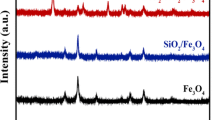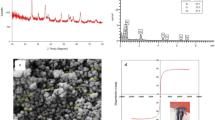Abstract
Fe3+-doped TiO2 nanoparticles (NPs) were synthesized via the solvothermal method to develop a cost-effective adsorbent for Congo red (CR) removal from aqueous solutions. The synthesized NPs were characterized by XRD, FTIR, FE-SEM, EDXS, and nitrogen adsorption isotherms. Results confirmed that the incorporation of Fe3+ into the TiO2 lattice effectively decreased the particle size, increased the Brunauer–Emmett–Teller (BET) surface area, and therefore improved the adsorption capacity of TiO2 doped with Fe3+. The anatase nanocrystalline phase with spherical-shaped particles of a mean diameter of 14.8 nm was produced for Fe3+-doped TiO2. The analysis of nitrogen adsorption isotherms revealed that the BET surface area of TiO2 doped with Fe3+ was as high as 194.82 m2.g−1, which was larger than that of pure TiO2 (161.36 m2.g−1). The equilibrium adsorption data were compatible with the Langmuir isotherm model; the maximum adsorption capacity of CR by TiO2 doped with Fe3+ reached 400 mg.g−1 at 30 °C, which was considerably higher than that of pure TiO2 (238 mg.g−1). Moreover, the equilibrium adsorption time of as-synthesized Fe3+-doped TiO2 NPs was significantly shorter than that of other metal oxides nanostructures in previous works, making them excellent candidates for wastewater treatment. Further studies demonstrated that the adsorption of CR onto the TiO2 doped with Fe3+ followed a pseudo-second-order kinetic model; the negative values of ∆G° and positive values of ∆H° indicated that the adsorption of CR by TiO2 doped with Fe3+ was spontaneous and endothermic in nature.
Graphical Abstract









Similar content being viewed by others
References
Zheng Z, Cheng B, Fan J, Yu J, Ho W (2021) Review on nickel-based adsorption materials for Congo red. J Hazard Mater 403:123559
Cao C, Xiao L, Liu L, Zhu H, Chen C, Gao L (2013) Visible-light photocatalytic decolorization of reactive brilliant red X-3B on Cu2O/crosslinked-chitosan nanocomposites prepared via one step process. Appl Surf Sci 271:105
Bilal M, Ihsanullah I, Shah MUH, Reddy AVB, Aminabhavi TM (2022) Recent advances in the removal of dyes from wastewater using low-cost adsorbents. J Environ Manage 321:115981
Zhang H, Hu J, Xie J, Wang S, Cao Y (2019) A solid-state chemical method for synthesizing MgO nanoparticles with superior adsorption properties. RSC Adv 9:2011–2017
Chethana M, Sorokhaibam LG, Bhandari VM, Raja S, Ranade VV (2016) Green approach to dye wastewater treatment using biocoagulants. ACS Sustain Chem Eng 4:2495–2507
Moussavi G, Mahmoudi M (2009) Degradation and biodegradability improvement of the reactive red 198 azo dye using catalytic ozonation with MgO nanocrystals. J Chem Eng 152:1–7
Zhao C, Yang B, Han J, Meng Y, Yu L, Hou D, Wang J, Zhao Y, Zhai Y, Wang S, Sun X (2018) Preparation of carboxylic multiwalled-carbon-nanotube modified poly(m-phenylene isophthalamide) hollow fiber nanofiltration membranes with improved performance and application for dye removal. Appl Surf Sci 453:502–512
Olivo-Alanis D, Garcia-Reyes RB, Alvarez LH, Garcia-Gonzalez A (2018) Mechanism of anaerobic bio-reduction of azo dye assisted with lawsone-immobilized activated carbon. J Hazard Mater 347:423–430
Gupta VK, Suhas (2009) Application of low-cost adsorbents for dye removal – A review. J Environ Manage 90:2313–2342
Han R, Ding D, Xu Y, Zou W, Wang Y, Li Y, Zou L (2008) Use of rice husk for the adsorption of congo red from aqueous solution in column mode. Bioresour Technol 99:2938–2946
Srilakshmi C, Saraf R (2016) Ag-doped hydroxyapatite as efficient adsorbent for removal of Congo red dye from aqueous solution: Synthesis, kinetic and equilibrium adsorption isotherm analysis. Microporous Mesoporous Mater 219:134–144
Zhang L, Tu L, Liang Y, Chen Q, Li Z, Li C, Wang Z, Li W (2018) Coconut-based activated carbon fibers for efficient adsorption of various organic dyes. RSC Adv 8:42280–42291
Pal J, Deb M (2014) Efficient adsorption of congo red dye from aqueous solution using green synthesized coinage nanoparticles coated activated carbon beads. Appl NanoSci 4(8):967–978
Vimonses V, Lei S, Jin B, Chow CWK, Saint C (2009) Kinetic study and equilibrium isotherm analysis of congo red adsorption by clay materials. J Chem Eng 148:354–364
Dawood S, Sen TK (2012) Removal of anionic dye congo red from aqueous solution by raw pine and acid-treated pinecone powder as adsorbent: Equilibrium, thermodynamic, kinetics, mechanism and process design. Water Res 46(6):1933–1946
Yek PNY, Peng W, Wong CC, Liew RK, Ho YL, Mahari WAW, Azwar E, Yuan TQ, Tabatabaei M, Aghbashlo M, Sonne C, Lam SS (2020) Engineered biochar via microwave CO2 and steam pyrolysis to treat carcinogenic Congo red dye. J Hazard Mater 395:122636
Lian L, Guo L, Guo C (2009) Adsorption of Congo red from aqueous solutions onto Ca-bentonite. J Hazard Mater 161:126–131
Huang W, Xu J, Lu D, Deng J, Shi G, Zhou T (2018) Rational design of magnetic infinite coordination polymer core-shell nanoparticles as recyclable adsorbents for selective removal of anionic dyes from colored wastewater. Appl Surf Sci 462:453–465
Rath PP, Behera SS, Priyadarshini B, Panda SR, Mandal D, Sahoo T, Mishra S, Sahoo TR, Parhi PK (2019) Influence of Mg doping on ZnO NPs for enhanced adsorption activity of Congo Red dye. Appl Surf Sci 491:256–266
Guo H, Chen J, Weng W, Zheng Z, Wang D (2014) Adsorption behavior of Congo red from aqueous solution on La2O3-doped TiO2 nanotubes. J Ind Eng Chem 20:3081–3088
Galvani GM, Zito CA, Perfecto TM, Otavio J, Malafatti D, Paris EC, Volanti DP (2022) Two-dimensional NiO nanosheets for efficient Congo red adsorption removal. Mater Chem Phys 290:126591
Cai W, Hu Y, Chen J, Zhang G, Xia T (2012) Synthesis of nanorod-like mesoporous γ-Al2O3 with enhanced affinity towards Congo red removal: Effects of anions and structure-directing agents. CrystEngComm 14:972–977
Lei C, Zhu X, Zhu B, Yu J, Ho W (2016) Hierarchical NiO–SiO2 composite hollow microspheres with enhanced adsorption affinity towards Congo red in water. J Interface Sci 466:238–246
Hoffmann MR, Martin ST, Choi W, Bahnemann DW (1995) Environmental applications of semiconductor photocatalysis 95:69–96
Ahn SH, Koh JH, Seo JA, Kim JH (2010) Structure control of organized mesoporous TiO2 films templated by graft copolymers for dye-sensitized solar cells. Chem Commun 46:1935–1937
Leong HJ, Oh SG (2018) Preparation of antibacterial TiO2 particles by hybridization with azelaic acid for applications in cosmetics. J Ind Eng Chem 66:242–247
Mai NTT, Nga NK, Hue DTM, Dung TN, Chinh HD, Huy TQ (2021) Characterizations of Co2+ and Fe3+ codoped TiO2 nanomaterials for photocatalytic degradation of organic pollutants under visible light irradiation light. Adsorp Sci Technol Article ID 9193052
Fujishima A, Zhang X (2006) Titanium dioxide photocatalysis: Present situation and future approaches. C R Chim 9:750–760
Barakat MA, Schaeffer H, Hayes G, Ismat-Shah S (2004) Photocatalytic degradation of 2-chlorophenol by Co-doped TiO2 nanoparticles. Appl Catal B 57:23–30
Li Z, Shen W, He W, Zu X (2008) Effect of Fe-doped TiO2 nanoparticle derived from modified hydrothermal process on the photocatalytic degradation performance on methylene blue. J Hazard Mater 155:590–594
Wang XH, Li JG, Kamiyama H, Moriyoshi Y, Ishigaki T (2006) Wavelength-Sensitive Photocatalytic Degradation of Methyl Orange in Aqueous Suspension over Iron(III)-doped TiO2 Nanopowders under UV and Visible Light Irradiation. J Phys Chem B 110:6804–6809
Sun T, Fan J, Liu E, Liu L, Wang Y, Dai H, Yang Y, Hou W, Hu X, Jiang Z (2012) Fe and Ni co-doped TiO2 nanoparticles prepared by alcohol-thermal method: Application in hydrogen evolution by water splitting under visible light irradiation. Powder Technol 228:210–218
Rathore N, Shukla RK, Dubey KC, Kulshreshtha A (2020) Synthesis of undoped and Fe doped nanoparticles of TiO2 via co-precipitation technique and their characterizations. Mater Today Proceed 29:861–865
Wang Q, Xu S, Shen F (2011) Preparation and characterization of TiO2 photocatalysts co-doped with iron (III) and lanthanum for the degradation of organic pollutants. Appl Surf Sci 257:7671–7677
Holzwarth U, Gibson N (2011) The Scherrer equation versus the Debye-Scherrer equation. Nature Nanotech 6(9):534
Sotomayor FJ, Cychosz KA, Thomme M (2018) Characterization of Micro/Mesoporous Materials by Physisorption: Concepts and Case Studies. Acc Mater Surf Res 3(2):34–50
Purkait MK, Maiti A, DasGupta S, De S (2007) Removal of congo red using activated carbon and its regeneration. J Hazard Mater 145:287–295
Tang H, Huang H, Wang X, Wu K, Tang G, Li C (2016) Hydrothermal synthesis of 3D hierarchical flower-like MoSe2 microspheres and their adsorption performances for methyl orange. Appl Surf Sci 379:296–303
Lei C, Pi M, Jiang CB, Yu J (2017) Synthesis of hierarchical porous zinc oxide (ZnO) microspheres with highly efficient adsorption of Congo red. J Colloid Interf Sci 490:242–251
Xu J, Xu D, Zhu B, Cheng B, Jiang C (2018) Adsorptive removal of an anionic dye Congo red by flower-like hierarchical magnesium oxide (MgO)-graphene oxide composite microspheres. Appl Surf Sci 435:1136–1142
Chen H, Zheng Y, Cheng B, Yu J, Jiang C (2018) Chestnut husk-like nickel cobaltite hollow microspheres for the adsorption of Congo red. J Alloys Comp 735:1041–1051
Namin ZA, Norouzbeigi R, Shayesteh H (2022) Green mediated combustion synthesis of copper zinc oxide using Eryngium planum leaf extract as a natural green fuel: Excellent adsorption capacity towards Congo red dye. Ceram Inter 48:20961–20973
Kyzas GZ, Kostoglou M, Lazaridis NK (2009) Copper and Chromium (VI) removal by chitosan derivatives-equilibrium and kinetic studies. J Chem Eng 152:440–448
Sun J, Zhang Z, Ji J, Dou M, Wang F (2017) Removal of Cr6+ from wastewater via adsorption with high-specific-surface-area nitrogen-doped hierarchical porous carbon derived from silkworm cocoon. Appl Surf Sci 405:372–379
Acknowledgements
This study was funded by the Vietnam National Foundation for Science and Technology Development (NAFOSTED) under grant number 104.03-2019.313
Author information
Authors and Affiliations
Corresponding author
Ethics declarations
Conflicts of interest
There are no conflicts of interest to declare.
Additional information
Publisher's Note
Springer Nature remains neutral with regard to jurisdictional claims in published maps and institutional affiliations.
Supplementary Information
Below is the link to the electronic supplementary material.
Rights and permissions
Springer Nature or its licensor (e.g. a society or other partner) holds exclusive rights to this article under a publishing agreement with the author(s) or other rightsholder(s); author self-archiving of the accepted manuscript version of this article is solely governed by the terms of such publishing agreement and applicable law.
About this article
Cite this article
Nga, N.K., Nga, N.T.T. Highly adsorptive removal of Congo red from aqueous solution using TiO2 doped with Fe3+ nanoparticles. Colloid Polym Sci 301, 491–503 (2023). https://doi.org/10.1007/s00396-023-05084-3
Received:
Revised:
Accepted:
Published:
Issue Date:
DOI: https://doi.org/10.1007/s00396-023-05084-3




